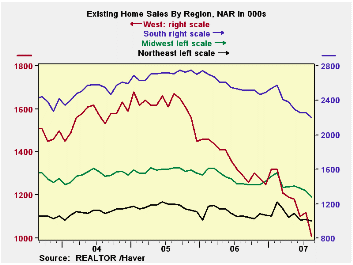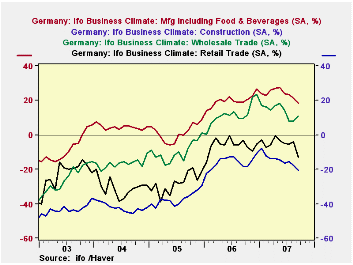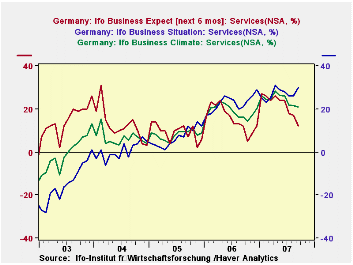 Global| Sep 25 2007
Global| Sep 25 2007U.S. Existing Home Sales Weakness Accelerates in the West
Summary
As of last month, the Northeast had seemed to stabilize. So had the Midwest. In the South conditions had still been easing but with a hint of flatness month/month in July. But in August the South saw sales fall again and the West saw [...]

As of last month, the Northeast had seemed to stabilize. So had the Midwest. In the South conditions had still been easing but with a hint of flatness month/month in July. But in August the South saw sales fall again and the West saw the bottom fall out of an already weak market. The drop off in the West is simply stunning. It is the largest drop in this episode of declining sales. What we find is that sales have pulled back sharply in this period when mortgage availability came into question in the middle of the financial sector mortgage-led melt down. Since Jumbo mortgages were one of the products at issue in this mini-crisis, it is not surprising to find that the West, California’s region where the jumbo mortgage is also the norm, is the region that is most affected in August. The Midwest and Northeast are still under pressure, the South appears to see a continued and fairly ongoing fall off, but the West is a disaster.
The Northeast and Midwest are holding their year/year declines to about 10%, the South is off by 13% but the West is now down by nearly 22% year-over-year.
While the median price has slipped to $224,500, that is an erosion of only about 2.5% from its recent peak. The problems so far do not seem to be crushing home prices. The home sales market is doing its usual thing which is to become less liquid and to maintain house prices.
We now see vast regional differences in terms of what has happened over the past year. The West, the region with the highest home prices has been hit the hardest. But the Northeast with the second highest prices has been the most insulated. The seize-up is simply not just about high-priced homes.
The Northeast is more fully developed and probably has less competition from tracts of new homes. Plus inflows of monies from nonresidents have helped to prop up prices in some the East coast housing markets giving them some resiliency.
Summing Up:Still the facts are clear and housing is in the soup. The financial mess has had spillover into the house sales market - not surprisingly. The report was weak enough to inject new life into the bond market where the price of bonds had been selling off since the Fed started its easing process. The question markets are grappling with now is how weak is the economy really and how far will the Fed choose to go? There is tension between those thinking that the Fed will overdo it since economy is not really that weak and those who think that the economy is weak and will need more help. For the moment stocks are assuming that there will be growth from one channel or another. The macro picture is muddied by the GM strike that could weaken things a lot more if that strike drags on.
| Existing Home Sales Summary | |||||
|---|---|---|---|---|---|
| (Existing Home Sales: In Thousands' -- National Association of Realtors) | |||||
| Month | Total | North-East | Mid-West | South | West |
| Aug.07 | 5,500 | 1000 | 1280 | 2200 | 1010 |
| Jul.07 | 5,750 | 1020 | 1350 | 2260 | 1120 |
| Jun.07 | 5,760 | 1010 | 1380 | 2260 | 1100 |
| May.07 | 5,980 | 1090 | 1410 | 2300 | 1180 |
| Apr.07 | 6,010 | 1040 | 1400 | 2380 | 1190 |
| Mar.07 | 6,150 | 1140 | 1390 | 2410 | 1210 |
| Feb.07 | 6,680 | 1220 | 1560 | 2570 | 1320 |
| Jan.07 | 6,440 | 1060 | 1520 | 2540 | 1320 |
| Dec.06 | 6,270 | 1070 | 1460 | 2490 | 1250 |
| Nov.06 | 6,250 | 1080 | 1420 | 2470 | 1280 |
| Oct.06 | 6,270 | 1030 | 1420 | 2520 | 1300 |
| Sep.06 | 6,230 | 1040 | 1420 | 2520 | 1260 |
| Aug.06 | 6,310 | 1060 | 1430 | 2520 | 1290 |
| Percent Changes: Existing Home Sales | |||||
| Mo/Mo% | Total | North-East | Mid-West | South | West |
| Aug.07 | -4.3% | -2.0% | -5.2% | -2.7% | -9.8% |
| Jul.07 | -0.2% | 1.0% | -2.2% | 0.0% | 1.8% |
| Jun.07 | -3.7% | -7.3% | -2.1% | -1.7% | -6.8% |
| May.07 | -0.5% | 4.8% | 0.7% | -3.4% | -0.8% |
| 3-Mo:ar | -32.1% | -33.0% | -36.9% | -17.4% | -57.6% |
| 6-mo:ar | -35.3% | -36.1% | -35.9% | -28.8% | -47.0% |
| 1-Year | -12.8% | -5.7% | -10.5% | -12.7% | -21.7% |
| Prices: | Median Prices | ||||
| One Mo: | -0.1% | -0.7% | 2.2% | -1.7% | 0.6% |
| One Year: | -0.6% | 5.9% | -1.8% | -3.2% | 0.9% |
by Robert Brusca September 25, 2007

With the September Conference Board report we have a bit more of a dilemma on our hands. While the August job report was very weak as the month went on consumer confidence did not weaken from its earliest readings which were themselves weak. Both the weekly consumer comfort gauge and the preliminary University of Michigan report showed a firming in confidence that has continued. Now, in September, we get a big drop in confidence, the second in a row from the Conference Board measure. Neither the University of Michigan preliminary reading nor the weekly consumer comfort reports are in early agreement with this weakness. Moreover, the weekly jobless claims are lower despite the fact that the Conference Board report is supposed to be more labor-market centric than the others. We are left to ponder which of these reports really has the pulse of the nation and which of them has glommed onto pulse of the family dog.
The range data on the detailed components of the Conference Board index show us that this weakness is fairly widespread across expectations in the report.
Expectations are the weakest readings residing in the middle of their range at the 48th percentile. The present situation comes out in the top 25 percent of the range - nearly the top 20%.
Between the two present situation readings, the business conditions response is the weaker in its range at the 53 percent mark while employment is near the top 30% of its range.
Among the expectations components both the business and employment indexes are weak in their respective ranges, bottom 35% to 40%. But income, a more stable component, is holding up in the top third of its range.
The planned spending components are exceptionally weak. Plans to buy an automobile are in the bottom 15% of their range; plans to buy a house are in the bottom 5% of their range.
The Conference Board reading is weak. It is at its weakest point since an unusually sharp drop late in 2005. Since other measures have not gone along with this one, we will want to watch closely if the Conference Board is isolated or just early in its report of weakness.
| Table of Comparison for Conference Board Survey | |||||
|---|---|---|---|---|---|
| Overall Index | Current | Max | Min | Year Ago | Pctile |
| Confidence Index | 99.8 | 111.9 | 61.4 | 105.9 | 76.0% |
| Present Situation | 121.7 | 138.5 | 59.7 | 128.3 | 78.7% |
| Expectations | 85.2 | 110.2 | 61.4 | 91.0 | 48.8% |
| Present Situation | Current | Max/Oct'03 | Min/Oct'03 | Year Ago | Pctile |
| Business Conditions | 53.9 | 57.3 | 50.0 | 55.9 | 53.4% |
| Good | 25.7 | 29.7 | 13.6 | 27.3 | 75.2% |
| Bad | 17.9 | 31.0 | 14.5 | 15.6 | 20.6% |
| Normal | 56.4 | 61.5 | 53.1 | 57.1 | 39.3% |
| Employment | 51.8 | 55.7 | 43.2 | 52.7 | 68.9% |
| Jobs Plentiful | 25.7 | 30.3 | 9.9 | 26.2 | 77.5% |
| Not so Plentiful | 52.2 | 60.2 | 50.7 | 52.9 | 15.8% |
| Jobs Hard To Get | 22.1 | 35.1 | 17.9 | 20.9 | 24.4% |
| Expectations(6-mo) | Current | Max | Min | Year Ago | Pctile |
| Business Conditions | 51.9 | 58.0 | 47.8 | 53.1 | 40.4% |
| Better | 15.6 | 28.0 | 13.0 | 16.5 | 17.3% |
| Worsen | 11.8 | 20.0 | 6.2 | 10.3 | 40.6% |
| Same | 72.6 | 76.7 | 65.0 | 73.2 | 65.0% |
| Employment | 47.3 | 53.0 | 44.2 | 49.1 | 35.6% |
| More Jobs | 13.3 | 22.2 | 10.8 | 14.7 | 21.9% |
| Fewer Jobs | 18.7 | 28.5 | 13.5 | 16.5 | 34.7% |
| The Same | 68.0 | 72.5 | 59.1 | 68.8 | 66.4% |
| Income | 55.9 | 57.1 | 53.4 | 55.7 | 68.5% |
| Increase | 20.4 | 22.7 | 15.8 | 20.2 | 66.7% |
| Decrease | 8.6 | 13.4 | 7.2 | 8.8 | 22.6% |
| Same | 71.0 | 74.5 | 67.8 | 71.0 | 47.8% |
| Buying Plans: | |||||
| Automobile | Current | Max | Min | Year Ago | Pctile |
| Yes | 5.2 | 8.7 | 4.6 | 6.0 | 14.6% |
| New | 2.7 | 4.3 | 2.1 | 2.9 | 27.3% |
| House | Current | Max | Min | Year Ago | Pctile |
| Yes | 2.7 | 4.5 | 2.6 | 2.9 | 5.3% |
| New | 0.7 | 1.7 | 0.5 | 1.0 | 16.7% |
| Major Appliance | 29.7 | 35.3 | 25.0 | 27.5 | 45.6% |
| Buying index | 81.4 | 107.7 | 74.3 | 98.4 | 21.3% |
| New Purchase Index | 76.5 | 107.9 | 61.6 | 94.3 | 32.2% |
| From Dec '01 'til | Sep-07 | ||||
by Louise Curley September 25, 2007


The IFO's headline series on the business climate in Germany's manufacturing, construction and trade industries continues to erode. Since April of this year the diffusion index, which measures the excess of optimists over pessimists, has declined from 16.3% to 7.6% in September. By September pessimists outweighed optimists by 20.7% in the construction industry and by 12.9% in retail trade. Although the excess of optimists over pessimists in manufacturing has been declining, it was still a positive 18.2% in September. In wholesale trade, the excess of optimists actually increased to 10.7% in September from 8.1% in August. The diffusion indexes for the business climate in the four industries are shown in the first chart.
The second chart shows the diffusion indexes for the current situation in these industries. As of now, data are available only through August. At that time participants in the survey engaged in manufacturing, construction and retail trade saw improvement in their current conditions. As for expectations for the six months ahead, which, again, are available only through August, it was only those engaged in wholesale trade who looked for an improvement, as can be seen in the third chart.
The IFO has been publishing data on the service industry since May, 2001. (The industrial data go back to January, 1991.) The survey in the services is based on about 2,000 responses of firms in important, especially business-oriented segments of the tertiary sector (excl. distribution, financial services, leasing, insurance and government. These data have not been seasonally adjusted, nor have they been incorporated into the headline business climate measures. Diffusion indexes are available for the business climate, current conditions and expectations for the service industry. These are shown in the fourth chart. The appraisal of current conditions in the service industries improved in September, but the diffusion indexes for expectations and the overall climate declined. In general, the diffusion indexes for the business climate, current conditions, and expectations for the service industry tend to be higher than those for the manufacturing and trade industries.


| GERMAN IFO BUSINESS SURVEY DIFFUSION INDEXES (% BALANCE) | Sep 07 | Aug 07 | Jul 07 | Jun 07 | May 07 | Apr 07 |
|---|---|---|---|---|---|---|
| Business Climate (Headline Series) | 7.6 | 10.7 | 12.0 | 13.1 | 16.2 | 16.3 |
| Manufacturing | 18.2 | 21.5 | 23.4 | 23.8 | 27.5 | 27.1 |
| Construction | -20.7 | -17.5 | -15.3 | -16.1 | -14.7 | -14.0 |
| Wholesale Trade | 10.7 | 8.1 | 8.0 | 14.1 | 18.3 | 17.1 |
| Retail Trade | -12.9 | -4.3 | -5.5 | -5.1 | -3.2 | -0.5 |
| SURVEY OF SERVICE INDUSTRIES | ||||||
| Business Climate | 20.8 | 21.5 | 22.0 | 26.0 | 26.5 | 28.5 |
| Current Conditions | 30.0 | 26.0 | 26.0 | 28.0 | 29.0 | 31.0 |
| Expectations | 12.0 | 17.0 | 18.0 | 24.0 | 24.0 | 26.0 |
Robert Brusca
AuthorMore in Author Profile »Robert A. Brusca is Chief Economist of Fact and Opinion Economics, a consulting firm he founded in Manhattan. He has been an economist on Wall Street for over 25 years. He has visited central banking and large institutional clients in over 30 countries in his career as an economist. Mr. Brusca was a Divisional Research Chief at the Federal Reserve Bank of NY (Chief of the International Financial markets Division), a Fed Watcher at Irving Trust and Chief Economist at Nikko Securities International. He is widely quoted and appears in various media. Mr. Brusca holds an MA and Ph.D. in economics from Michigan State University and a BA in Economics from the University of Michigan. His research pursues his strong interests in non aligned policy economics as well as international economics. FAO Economics’ research targets investors to assist them in making better investment decisions in stocks, bonds and in a variety of international assets. The company does not manage money and has no conflicts in giving economic advice.






